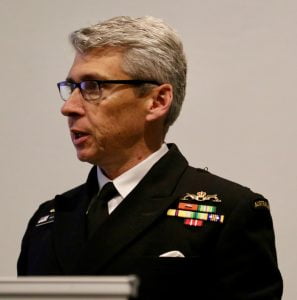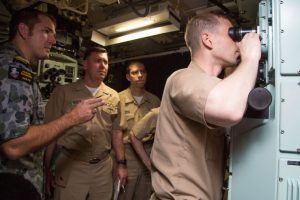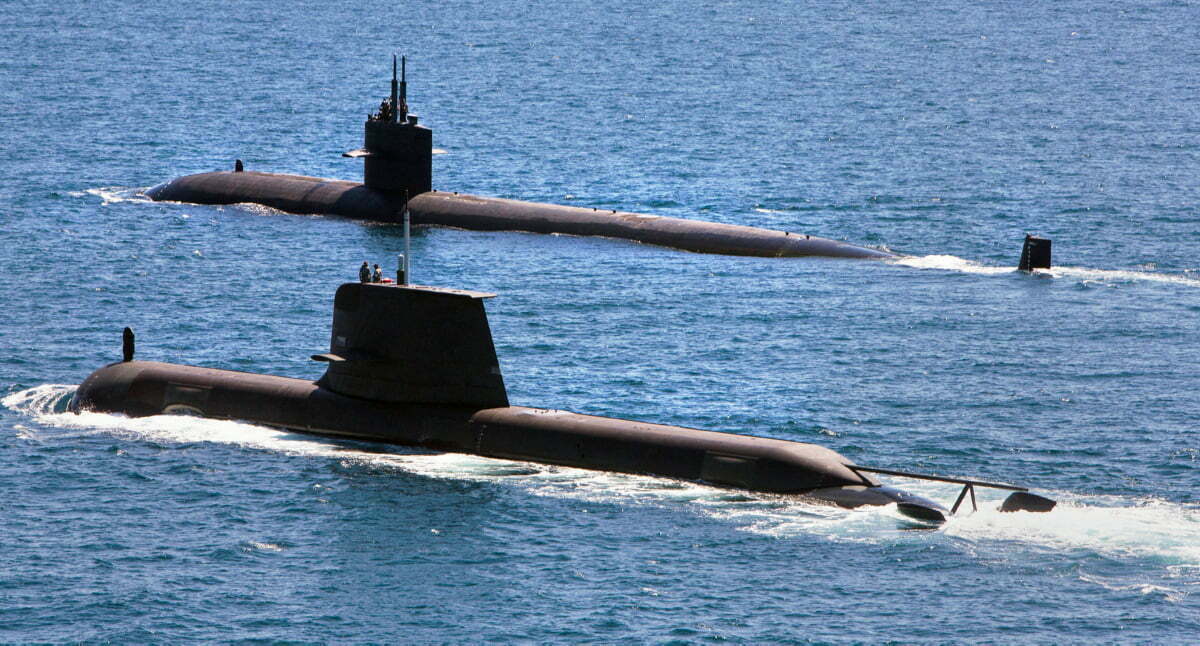By Robbin Laird
The Williams Foundation seminar on August 23, 2018 focused on the evolving role of independent strike within the evolving Australian deterrent strategy.
Currently, the Australian submarine force provides the longest-range stealth strike platform within the ADF.
Although it posseses modest force of six Collins class submarines, the Royal Australian Navy has focused on enhanced availability of these submarines to the joint commander.
With the upgrades on the Collins class, it is becoming a more effective platform in terms of integration with the US Navy as well.
The 2016 White Paper underscored the importance of Australia developing, building and evolving a new class of submarines which deliver a “regionally superior” conventionally powered submarine.
Submarines are an essential part of Australia’s naval capability, providing a strategic advantage in terms of surveillance and protection of our maritime approaches . The Government has determined that regionally superior submarines with a high degree of interoperability with the United States are required to provide Australia with an effective deterrent, including by making a meaningful contribution to anti-submarine warfare operations in our region .
The key capabilities of the future submarine will include: anti-submarine warfare; anti-surface warfare; intelligence, surveillance and reconnaissance; and support to special operations
The Government will increase the size of the submarine force from six to 12 boats . The doubling in size of the submarine fleet recognises that Australia will face a more challenging maritime environment in the decades ahead . By 2035, around half of the world’s submarines will be operating in the Indo-Pacific region where Australia’s interests are most engaged.
Australia has one of the largest maritime domains in the world and we need the capacity to defend and further our interests from the Pacific to the Indian Oceans and from the areas to our north to the Southern Ocean. Submarines are a powerful instrument for deterring conflict and a potent weapon should conflict occur.
The White Paper went on to add further detail with regard to the approach to ongoing modernization of the new submarines as well.
Australia’s new submarines will be supported by upgrades to enablers and facilities such as wharves and port facilities, as well as simulators, training and submarine rescue systems . The key strategic requirements for the future submarines include a range and endurance similar to the Collins Class submarine, sensor performance and stealth characteristics which are superior to the Collins Class, and upgraded versions of the AN/BYG-1 combat system and Mark 48 MOD 7 heavyweight torpedo jointly developed between the United States and Australia as the preferred combat system and main armament. The new submarines will have advanced communications systems to link with other Navy ships and aircraft to conduct anti-submarine warfare operations.
The acquisition of the 12 future submarines will commence in 2016 with the first submarines likely to begin entering service in the early 2030s . Construction of the 12 new submarines will extend into the late 2040s to 2050 timeframe . The length of the construction process will mean that Australia will need to be planning the follow-on submarine well before the last new submarine enters service.
To ensure no capability gap and the ability to progress development of a replacement submarine in the 2050s, the Government has decided to implement a rolling acquisition program for Australia’s submarine fleet.
A rolling acquisition program will ensure that Australia is able to maintain a fleet of 12 regionally superior submarines as submarine and anti-submarine technologies develop over the coming decades.
During the long life of the new submarines, the rapid rate of technological change and ongoing evolution of Australia’s strategic circumstances will continue.
As part of the rolling acquisition program, a review based on strategic circumstances at the time, and developments in submarine technology, will be conducted in the late 2020s to consider whether the configuration of the submarines remains suitable or whether consideration of other specifications should commence.
The initial number of new submarines was identified as 12 or double the size of the current sub force, but clearly there is an interest in building out that number if an effective design and production system is put in place.
If the promise of a “continuous build” approach is realized, the role of the submarine as a deterrent capability will be enhanced as modernization evolves more rapidly agains the threat environment.
At the seminar, Commodore Tim Brown RAN, Director General Submarines, Royal Australian Navy Strategic Command, Canberra, spoke with regard to the role of submarines within the overall Australian deterrent strategy.

As is the case with virtually all submarine presentations made in public, the discussion was a combination of stealth and statement.
The core message was clear throughout – the submarine was the key long-range strike capability within the ADF.
The modernization of Collins combined with the acquisition of a new submarine would enhance the role of the submarine within the ADF’s arsenal.
At the same time, working the evolution of maritime, air and space systems in the ASW function was a key compliment to the ability of the submarine to operate as a long-range strike asset as well.
One could add that with the return of the territorial dimension to Australian defense, namely the importance of Australian territory as a chessboard on which to operate the ADF or to host allied forces in times of crisis, the importance of the submarine in providing barrier defense against maritime strike threats was of growing importance as well.
During my time in Australia prior to the seminar, I visited the Osborne shipyards and got updates on the Collins upgrades and improved availability efforts.
I received as well briefings on the new submarine build approach and the two together from a single strand of building out enhanced submarine capabilities within an overall deterrent strategy.
The Collins submarines will be in operation through the mid 2030’s.
And the current cycle is to have two deployable submarines consistently available, with four available to the fleet commander, and of these four, three submarines consistently available for tasking with one in shorter term maintenance, and two submarines in long term maintenance and upgrade.
A new submarine is coming to the fleet in the 2030s, but given the experience with the Collins class, the Royal Australian Navy will play close attention to the question of built-in modernization and enhanced maintainability for the new class of submarines.
Within the overall defense business, there is a dynamic underway whereby the payload providers and the platform builders are dynamically changing their roles as the payload evolution is considerable more rapid than platform changes.
How might the platform side of this work more effectively with rapid changes on the payload and systems side of the house?
Clearly, the folks working Collins sustainment are thinking forward to what comes next.
Which given how important building platforms with enhanced modernization and maintainability built it is a good thing.
The Australians are coming to the new build submarine with several key expectations. The submarine is to be a large conventionally powered submarine with an American combat system on board allowing for integration with the US and Japanese fleets.
The Commonwealth has already signed the combat systems side of the agreement with Lockheed Martin and the LM/US Navy working relationship in the Virginia class submarine is the clear benchmark from which the Aussies expect their combat system to evolve as well.
The new submarine is not an off-the-shelf design; it leverages the French Navy’s Barracuda class submarine, but the new design will differ in a number of fundamental ways. The design contract is in place and the process is underway, with Australian engineers now resident in Cherbourg working with French engineers on the design.
The Aussies are looking to be able to have a fleet management approach to availability and one, which can be correlated with deployability, which is what they are working currently with the Collins class submarine.
This is clearly one of the baseline expectations by the Australians.
They simply do not want to build a submarine per se.
They want to set up an enterprise which can deliver high availability rates, enhanced maintainability built in, modularity for upgradeability and an ability to better embed the performance metrics into a clear understanding of deployability.
The continuous build approach will be correlated with domain knowledge of where does the Australian Navy need to go and how will it reshape its con-ops going forward and how do upgrades of the submarine fit into all of the above.
The continuous build concept is a key part of how the Australian Navy is looking at its contribution to their role within the joint force and their overall contribution to a credible deterrent strategy.
One needs to have a rapid modernization process for assets in operation in order to stay on the right side of the innovation curve to persuade adversaries that the risk of engaging the ADF is not worth the cost.
In my discussions at Fleet Base East with Captain Leif Maxfield, Deputy Commodore Warfare in the Royal Australian Navy, this priority was underscored.
The importance of getting the manufacturing/sustainment approach was highlighted by Captain Maxfield as a key element of the strategic shift to an effective joint warfighting strategy. If you do not design your ships with flexibility and agility in mind for a long-term effective modernization approach which encompasses joint integration, the RAN will simply not be able to get where it wants to go.
As Captain Maxfield emphasized, “We need to make sure that the integrated design concept and approach is on the ground floor as we build our new ships.
“We have shaped a navy-government-industry working relationship that we envisage will deliver life-cycle innovation for the joint force, not simply a one off build of a new combat ship.
“We are building a consolidated industry and service approach to ensure that will give us the best possible chance of delivering integrated output.”
Put another way, as the Aussies look to design, build and sustain a “regionally superior submarine,” an ongoing innovative relationship with industry is a key part of the deterrent approach.
As Captain Maxfield underscored: “The ability to deliver new platforms, to maintain those platforms, to sustain those platforms, to repair those platforms and keep ahead with cutting edge technology will rest on our ability to support the effort with our educational system, our industrial system and effective cross cutting learning fromthe fleet back to the yards as we move forward.”
The Featured Photo:
Los Angeles-class fast attack submarine, USS Albuquerque (SSN 706), and Collins-class submarine HMAS Rankin, in the waters off Rottnest Island, Western Australia.
United States Navy Submarine Officers, took the opportunity to visit HMAS Rankin, while at HMAS Stirling, Rockingham Western Australia in April 2015.
For many it was their first opportunity to tour a Collins Class diesel electric submarine. The officers are part of the USN Prospective Submarine Commanding Officers’ Course who are conducting the sea phase component of their training off the Western Australian Coast.
Credit: Australian Department of Defence
Preparing for Underwater Command
Published on LEUT Kara Wansbury (author), ABIS Julianne Cropley (photographer)
Commanding a submarine is arguably one of the toughest jobs in the world and the training for it is justifiably challenging as ten officers from the United States Navy recently found out during their Prospective Submarine Commanding Officers’ Course.
Participants visit Australia biennially, this year coinciding with a visit by USS Albuquerque, a Los Angeles class attack submarine.
Initially, the officers toured their host boat, HMAS Rankin, noting the differences between the boats and enjoy the hospitality, reinforcing the camaraderie that exists between submariners and the two navies.

The next phase of the course consisted of the officers embarking in HMAS Rankin and USS Albuquerqueand conducted simulated warfare exercises in both the submarines, testing their warfare knowledge, command skills and leadership over a few days in the waters off Western Australia.
The challenges of commanding a submarine are tested and whilst there are a number of commonalities between the two navies, there are marked differences said Commander Travis Zettel, United States Navy.
“Initially it is a steep learning curve for the officers.
“The routines at sea on submarines are different between our two navies, so they have to learn the difference fairly quickly before they head to sea,” Commander Zettel said.
Once the officers have successfully completed the course, they will go on to command United States Navy submarines.


